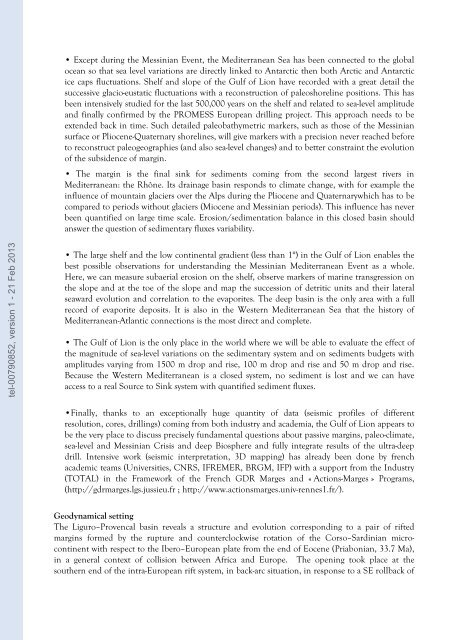Quantification des flux sédimentaires et de la subsidence du bassin ...
Quantification des flux sédimentaires et de la subsidence du bassin ...
Quantification des flux sédimentaires et de la subsidence du bassin ...
You also want an ePaper? Increase the reach of your titles
YUMPU automatically turns print PDFs into web optimized ePapers that Google loves.
tel-00790852, version 1 - 21 Feb 2013<br />
• Except <strong>du</strong>ring the Messinian Event, the Mediterranean Sea has been connected to the global<br />
ocean so that sea level variations are directly linked to Antarctic then both Arctic and Antarctic<br />
ice caps fluctuations. Shelf and slope of the Gulf of Lion have recor<strong>de</strong>d with a great d<strong>et</strong>ail the<br />
successive g<strong>la</strong>cio-eustatic fluctuations with a reconstruction of paleoshoreline positions. This has<br />
been intensively studied for the <strong>la</strong>st 500,000 years on the shelf and re<strong>la</strong>ted to sea-level amplitu<strong>de</strong><br />
and finally confirmed by the PROMESS European drilling project. This approach needs to be<br />
exten<strong>de</strong>d back in time. Such d<strong>et</strong>ailed paleobathym<strong>et</strong>ric markers, such as those of the Messinian<br />
surface or Pliocene-Quaternary shorelines, will give markers with a precision never reached before<br />
to reconstruct paleogeographies (and also sea-level changes) and to b<strong>et</strong>ter constraint the evolution<br />
of the subsi<strong>de</strong>nce of margin.<br />
• The margin is the final sink for sediments coming from the second <strong>la</strong>rgest rivers in<br />
Mediterranean: the Rhône. Its drainage basin responds to climate change, with for example the<br />
influence of mountain g<strong>la</strong>ciers over the Alps <strong>du</strong>ring the Pliocene and Quaternarywhich has to be<br />
compared to periods without g<strong>la</strong>ciers (Miocene and Messinian periods). This influence has never<br />
been quantified on <strong>la</strong>rge time scale. Erosion/sedimentation ba<strong>la</strong>nce in this closed basin should<br />
answer the question of sedimentary <strong>flux</strong>es variability.<br />
• The <strong>la</strong>rge shelf and the low continental gradient (less than 1°) in the Gulf of Lion enables the<br />
best possible observations for un<strong>de</strong>rstanding the Messinian Mediterranean Event as a whole.<br />
Here, we can measure subaerial erosion on the shelf, observe markers of marine transgression on<br />
the slope and at the toe of the slope and map the succession of d<strong>et</strong>ritic units and their <strong>la</strong>teral<br />
seaward evolution and corre<strong>la</strong>tion to the evaporites. The <strong>de</strong>ep basin is the only area with a full<br />
record of evaporite <strong>de</strong>posits. It is also in the Western Mediterranean Sea that the history of<br />
Mediterranean-At<strong>la</strong>ntic connections is the most direct and compl<strong>et</strong>e.<br />
• The Gulf of Lion is the only p<strong>la</strong>ce in the world where we will be able to evaluate the effect of<br />
the magnitu<strong>de</strong> of sea-level variations on the sedimentary system and on sediments budg<strong>et</strong>s with<br />
amplitu<strong><strong>de</strong>s</strong> varying from 1500 m drop and rise, 100 m drop and rise and 50 m drop and rise.<br />
Because the Western Mediterranean is a closed system, no sediment is lost and we can have<br />
access to a real Source to Sink system with quantified sediment <strong>flux</strong>es.<br />
•Finally, thanks to an exceptionally huge quantity of data (seismic profiles of different<br />
resolution, cores, drillings) coming from both in<strong>du</strong>stry and aca<strong>de</strong>mia, the Gulf of Lion appears to<br />
be the very p<strong>la</strong>ce to discuss precisely fundamental questions about passive margins, paleo-climate,<br />
sea-level and Messinian Crisis and <strong>de</strong>ep Biosphere and fully integrate results of the ultra-<strong>de</strong>ep<br />
drill. Intensive work (seismic interpr<strong>et</strong>ation, 3D mapping) has already been done by french<br />
aca<strong>de</strong>mic teams (Universities, CNRS, IFREMER, BRGM, IFP) with a support from the In<strong>du</strong>stry<br />
(TOTAL) in the Framework of the French GDR Marges and « Actions-Marges » Programs,<br />
(http://gdrmarges.lgs.jussieu.fr ; http://www.actionsmarges.univ-rennes1.fr/).<br />
Geodynamical s<strong>et</strong>ting<br />
The Liguro–Provencal basin reveals a structure and evolution corresponding to a pair of rifted<br />
margins formed by the rupture and counterclockwise rotation of the Corso–Sardinian microcontinent<br />
with respect to the Ibero–European p<strong>la</strong>te from the end of Eocene (Priabonian, 33.7 Ma),<br />
in a general context of collision b<strong>et</strong>ween Africa and Europe. The opening took p<strong>la</strong>ce at the<br />
southern end of the intra-European rift system, in back-arc situation, in response to a SE rollback of

















